
Catherine II of Russia is leaving Peterhof. Unknown author, early XIX century, Wikimedia Commons
Peterhof was founded as a country estate for Peter the Great, but developed into an exquisite royal residence following the tsar’s visit to Versailles in 1717. Its main elements were laid out by 1723 and included the Lower Park, Upper Garden, Sea Channel and two small palaces - Monplaisir and the Marli Palace.
Did you know? Peterhof is known as the Russian Versailles, as the French royal residence provided significant inspiration for its architecture and gardens.
Amongst those employed by Peter were Domenico Trezzini, founder of the architectural style Petrine Baroque and whose pieces are visible all over St Petersburg; Andre le Notre, who designed the gardens of Versailles; and Jean-Baptiste le Blond, St Petersburg’s first principal architect and city planner.
Did you know? Peterhof was not the first site chosen by the Tsar for his court; Strelna, slightly closer to St Petersburg, was the initial spot of choice, but the land there proved too marshy for much development.
The Grand Palace of Peterhof was gradually developed over one and a half centuries. In its place initially lay a plain building known as the Upper Chamber, whose simplicity did not balance the carefully designed Lower Park and its palaces. Le Blond and then Bartolemeo Rastrelli were commissioned to create something elegant but palatial. Rastrelli’s additions of two wings and gilded pavilions provided the most striking elements of the ensemble.
As with the Grand Palace, the famous Grand Cascade fountain was the work of consecutive architects and craftsmen. Its foundations were laid alongside the Sea Channel in the early 1700s and it was completed over the next 150 years with the help of Russia’s most proficient sculptors.
Did you know? 63 kilometres of canals connect the hundreds of fountains at Peterhof.
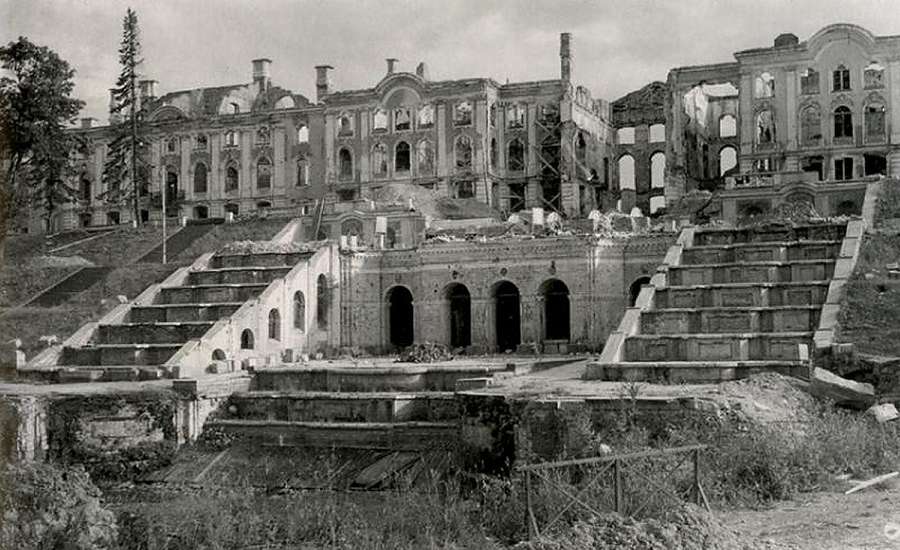
Photo by unknown author, 1943
Peterhof was devastated during the three year German occupation. Many of its fountains were destroyed, the Grand Palace was partially blown up, and its interiors almost completely burnt out in the subsequent fire. The English Palace, a masterful example of Russian Classicism, was irreparably damaged and could not be rebuilt. However, the importance that Peterhof held in the public consciousness was evident in the speed of the restoration process. The hard work of thousands of volunteers and engineers had Peterhof reopened by 1945.
Did you know? During wartime Peterhof’s Germanic-sounding name was Russified and changed to Petrodvorets, which means Peter’s Palace. The original name was not taken again until 1997.
Reconstruction has been ongoing since wartime, and a burst of funding for the tricentennial of St Petersburg provided for the restoration of the palace and its ensemble. In 1990, UNESCO included Peterhof on its list of World Heritage Sites.
Did you know? Peterhof is recognised as one of the Seven Wonders of Russia!
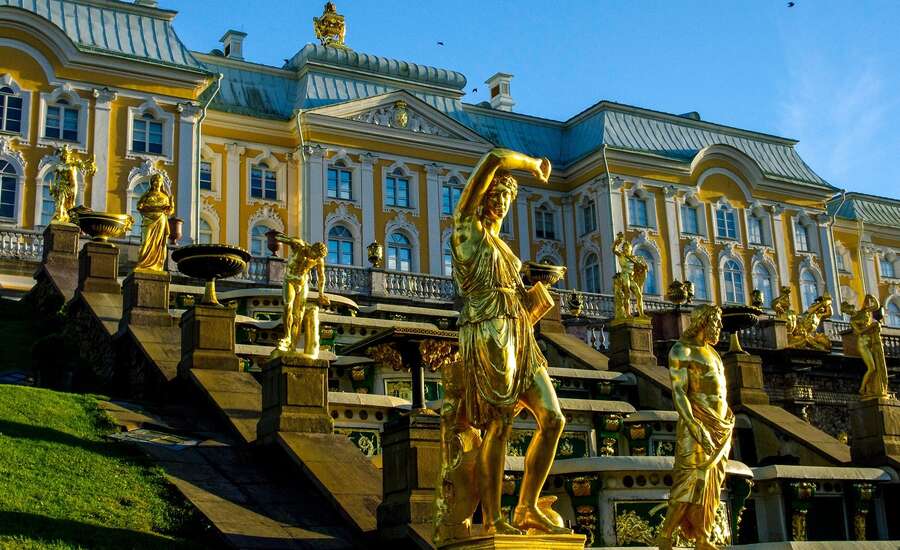
Photo by Ramon Perucho from Pixabay
The imposing central palace of Peterhof, built in late Baroque style. Explore over 30 rooms of the Grand Palace, beautifully restored in a mixture of styles from different eras. Particularly notable rooms include the Chesma Hall, Chinese Cabinets, Ceremonial Staircase, Throne Room and Ballroom.
Did you know? It is said that Empress Elizabeth ordered Rastrelli to use as much gold as possible when designing the ballroom, as she wished to impress the noble merchants who attended receptions there.
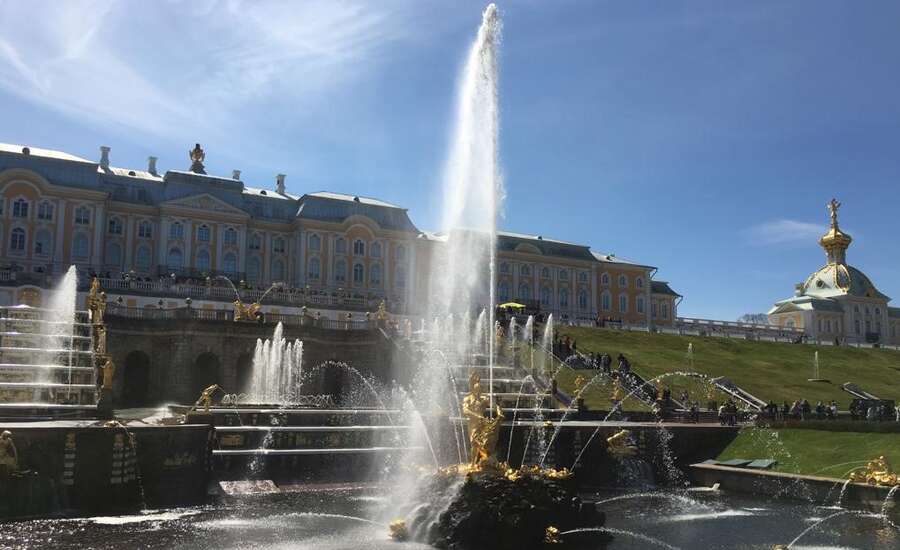
Photo by Express to Russia staff
Peterhof is famous for its fountains, and the central water feature is the Grand Cascade. The ensemble comprises several layers of terraces, two grottos, and statues depicting Biblical characters, animals, and the great Russian rivers. The Grand Cascade perfectly frames the Grand Palace behind it, and various performances and concerts are held against this backdrop. For the best view of the palace and fountain, make your way down the Sea Channel.
Did you know? There are 225 sculptures on the Grand Cascade!
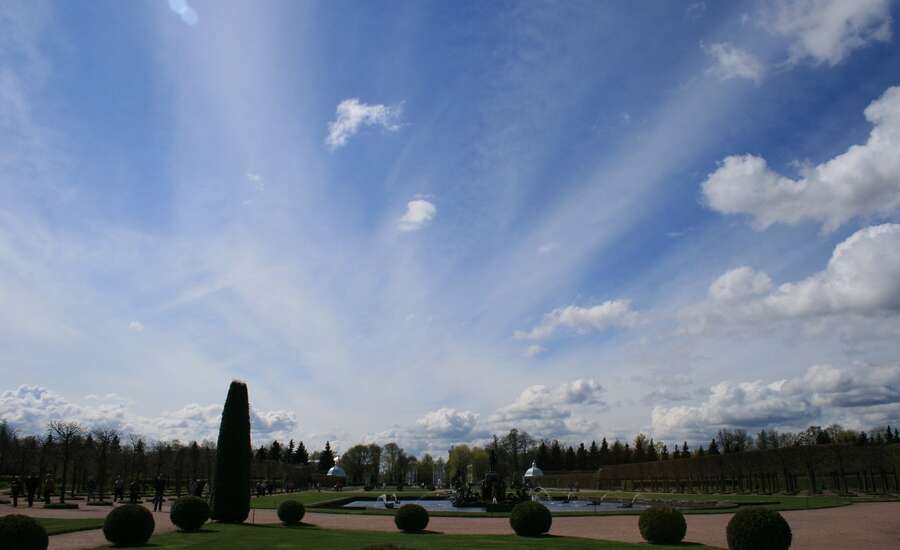
Photo by Sergey Mind on Unsplash
Under Bartolemeo Rastrelli, the Upper Garden exchanged its orchards, vegetable patches and fishponds for formal gardens complete with ornamental shrubbery, lawns, a rose garden, fountains, and statues. However, the layout has remained the same since the time of Peter the Great. Acting as the ceremonial gardens in front of the Grand Palace, this is the first glimpse of Peterhof visitors see upon arrival.
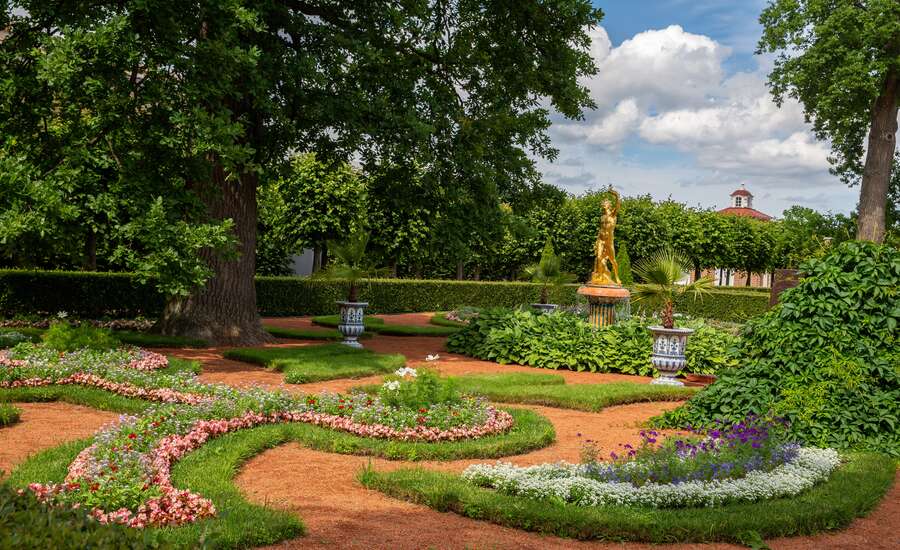
Photo by Sergey Mind on Unsplash
The Lower Park is a carefully laid out arrangement of verdant alleys intersected by fountains, rivers, and palaces, with three striking vistas, a shrub labyrinth, and three cascades echoing the three palaces. Despite the destruction of the German occupation, the Lower Park’s original layout has been masterfully preserved.
Did you know? There are 150 fountains within the Lower Park alone!
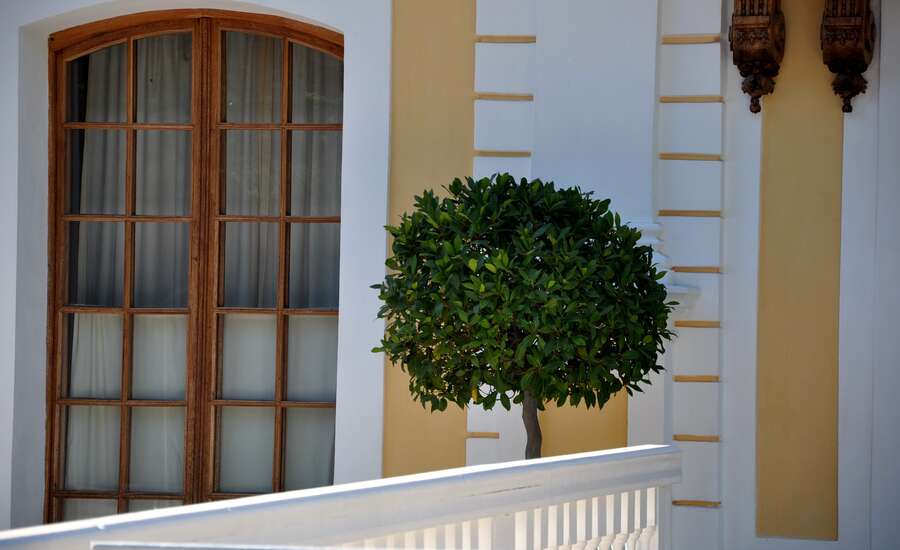
Photo by annanevskaja from Pixabay
Peter the Great’s favourite suburban residence, this small palace occupies a tranquil spot on the shore of the Finnish Gulf. Monplaisir was personally designed by Peter and had a homely and intimate atmosphere. Visitors can explore the Grand Hall, Peter’s personal office, and the gallery filled with European artwork which he collected during his travels. Outside the palace is an ornamental shrubbery and paved garden on the seashore, with views to the west coast of St Petersburg.

A harmonious Baroque mansion beautifully framed by the large pond to its front, the Marli Palace exudes an air of peacefulness. Its interior is modest and houses some of Peter the Great’s personal effects. To the south of the palace lies the Golden Hill Cascade, and to the north a footpath along the seashore.
Did you know? The Marli Palace’s ponds have been fish ponds since the days of Peter the Great. At specific times, a bell is rung to announce the feeding of the fish.
Address and Transport:
Razvodnaya Ulitsa 2, Peterhof, St Petersburg, 198510
There are a number of ways to get to Peterhof:
- By train from Baltiskiy Station to Noviy Peterhof Station.
- By bus No.200 or 210 from Avtovo metro station.
- If you take a private tour with Express to Russia, you will travel via your own private vehicle.
Did you know? You can also travel to Peterhof by hydrofoil! The Meteor hydrofoil travels between the Peterhof pier and St Petersburg city centre, and offers the most magnificent view of the Gulf of Finland and St Petersburg.
Website and Opening Hours:
https://en.peterhofmuseum.ru/
The grounds are open 9am - 8pm every day; the opening times of each building vary.
Join us on Facebook
We invite you to become a fan of our company on Facebook and read Russian news and travel stories. To become a fan, click here.
Join our own Russian Travel, Culture and Literature Club on Facebook. The club was created to be a place for everyone with an interest in Russia to get to know each other and share experiences, stories, pictures and advice. To join our club, please follow this link.